
DOMAIN is a 2v2 multiplayer map I created in Halo's level editor. This time I took a different approach - instead of deriving its design from a particular creative concept, I tailored it to a target audience, like a product. I made this map specially for my friend group that has a certain preference in shooters. The result exceeded my expectations: the experience ended up being genuinely engaging, despite us not being familiar with the Halo Franchise.
It's also a project where research ended up being quite significant. I previously explored three other level editors before settling on Forge, and I also spent some time exploring the history of arena shooters and as well as why they are no longer prevalent on the market.
Team: 1 person Tools: Halo Infinite (Forge) Roles: Research, Design, Testing Duration: ~3 weeks
Gameplay
Showcase
(Without Ceilings)





How it started
Research
Knowing the interests of my friend group, as well as them being familiar with most of the big shooter games on the market, I decided to look into arena shooters as something to take inspiration from for Domain. They are rare to come by nowadays, and other alternatives like tactical or extraction shooters tend to slow down the gameplay for the sake of immersion, strategy, or other design goals. This and other such details directed this project towards what my friend group enjoys, without being strongly influenced by the mainstream or other things that could hinder the project's focus.

I've also tried several different level editors for the same reason. While researching different genres, I also looked at the capabilities of each editor and whether it suits the needs of the project.
-
I started with Far Cry Arcade and encountered some friction points. It's not as convenient for designing vertical geometry, and it requires purchasing Far Cry 5.
-
Hammer became next, which, unfortunately, wasn't as capable as I expected. Despite being one of the most popular editors, its limitations mainly resemble outdated mechanics made for games over 20 years old.
-
And so I settled on Halo Forge. It's updated with each new game, and the Halo franchise borrows many mechanics one can find in arena shooters, which is something I was looking to replicate.
Initial Sketch

A
B
A - long-range power weapon
B - short-range power weapon
Since ambitious scale is something that wouldn't pay off greatly in this project, I went with the design of a symmetric arena map. It's not large, but it leaves plenty of room for decision-making, thanks to its weapons and abilities. It also allowed for rapid iterations and quick changes, which were very helpful in this project.
The map contained a grappling hook spawn and two power weapon spawns: long-range and short-range weapons. The idea of this map was to collect the strongest combination of grappling hook + the melee weapon, where the former is found on the most vulnerable point of the map and the latter on the most protected. The long-range weapon served as a counter to this strategy, and it could be collected from a small "floating island" that can be reached via jump pads.
How it's going
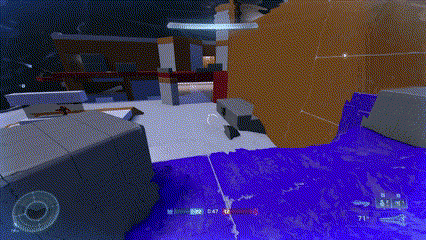
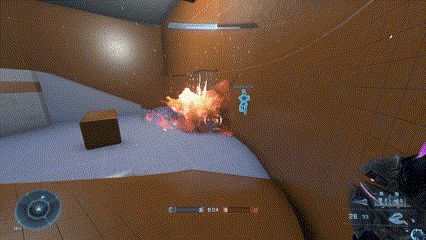
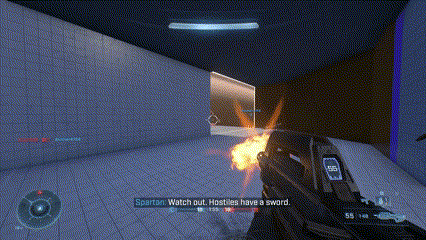
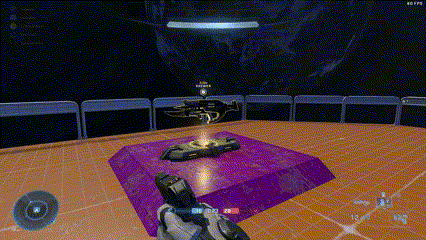
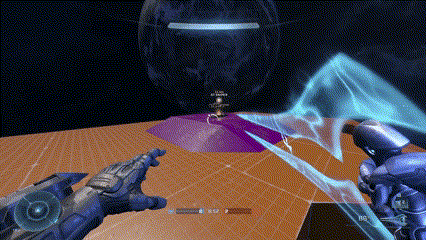
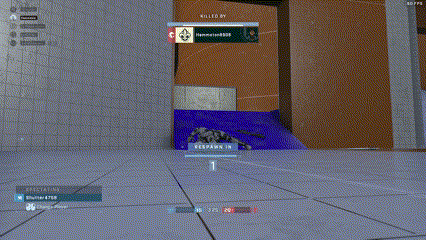
Summary
The very first playtest revealed the potential of the map: a compact, engaging space that utilises short-range and long-range. One can prevail over the other throughout a match, but neither takes over the game entirely because of the number of players. Since both weapons balance each other out, the dynamic always shifts, diversifying the gameplay.
The remaining iterations primarily focused on achieving balance and utilizing the available space. The first iteration contained a lot of white space as well as geometry that didn't contribute to the player's decision-making. Corridors were narrowed down and reshaped, starting weapons were switched, and the respawn time went up to 10 seconds. As the long-range power weapon, the sniper rifle was replaced with a speargun, since the former proved to be a weapon with no weaknesses on this map.
Playtesting
The Energy Sword
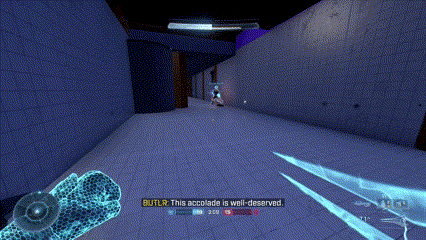

Meme made by my friend about the energy sword :)
The energy sword continued to define the map throughout its entire development. As I initially planned, the sword and the hook provided a unique playstyle that could compete with long-range weapons.
Soon enough, the sword became quite dominant. The starting weapon couldn't compete with the speed of the sword and its "jumpscary" nature. Hearing a hook used and a kill from behind is an experience we shared some laughs over, but it was clear that something had to be done about it.
There are many weapons in Halo Infinite, and counting on the right one to drop from didn't feel right. Thus, a small change was introduced: players were given MA5K Avenger from the start - a short-range weapon that's not as forgiving against the sword. Leaving a smaller chance to get a kill with a sword, it was later supported with map changes like the fast corridors and the power equipment, like invisibility.
The Rifle
The power of the rifle mainly depended on the floating island it's located on. The island had two floors, and the way to get to it was through jumpads on either side of the map. The rifles in Halo Infinite felt generally balanced, and if one player started dominating a map with it, they could still be taken down through teamwork - something that worked well in our friend group. The issue arose when two players ended up on that island with the same rifle - that's when the map felt most controlled, and with no way out.
For that reason, the island was decreased in size, so reaching the sniper would become easier. An attempt to capture the island was made through a teleporter, but it ended up being quite predictable. The final solution was switching the sniper rifle for the Skewer, a one-shot projectile weapon with 4 bullets and a long reload.
V1

V2

V3

The Center
The map's area with the least cover was perhaps the most challenging for me to design. Since items and weapons define where fights take place, I was left with a lot of white space where the player's pathing never went through. Adding more objects to hide behind felt pointless, and so I was looking for other ways of making that space engaging. In one iteration, a high ground was added where players could find power (legendary) equipment. The idea was that it's only reachable with a grappling hook, but soon I realised it takes time to switch between equipment since the player has only one slot for them, so this idea was scratched.
And so I decided to work with Forge's blueprints - I created two areas where players' movement speed doubles through a simple node system. That ended up being a very welcomed change: the center became even quicker to reach (as well as the opponents' base), emphasizing any item that can be put there.
The Blueprint (Click to Enhance)

V1

V2

V3
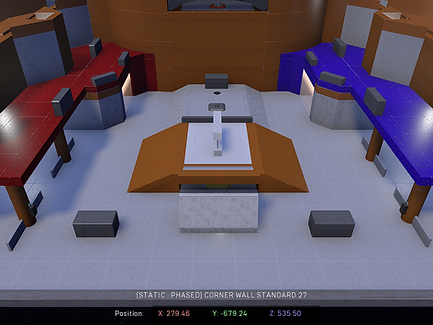
"Before and After"


Instead of simply obstructing the view, the geometry was reshaped in favor of players' choices. On the second image, one can now get on a small high ground on the right to face the enemy around the corner at an equal level.


This area inside the structure simply needed more diversity and purpose. The last iteration makes a better use of its spaciousness and now directs the player to its focal points (guns and abilities) with improved geometry.


Something I included for the sake of aesthetics ended up creating more friction for players. The whole in the elevation was removed, and color was added. The area now has more contrast, and it's easier to make sense of it.
Conclusion
-
This project is now my small personal achievement because of how positively it was received in my friend group. We played on this map regularly, often enjoying it more than the other games we typically played in the evenings, which is something I didn't expect from a project of such scope.
-
I've also reached out to other players to get feedback. Their perspective was different, highlighting issues I haven't encountered before, like the long-range power weapon being too powerful. This approach helped to uncover problems that weren't relevant at the time, but which would become apparent in the long term.
